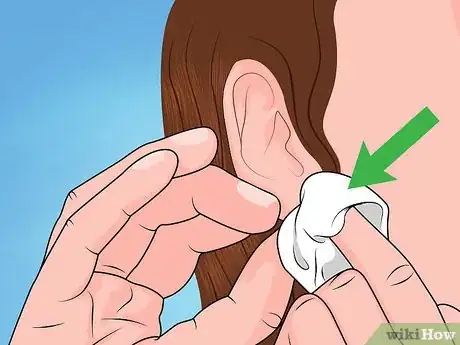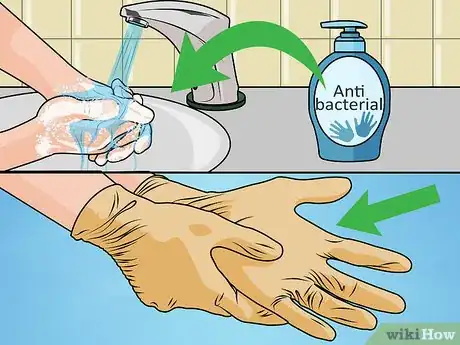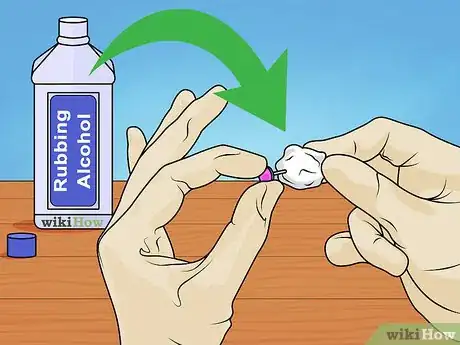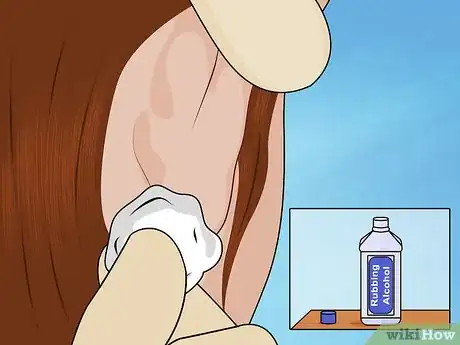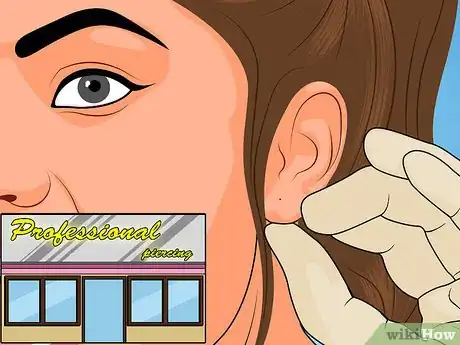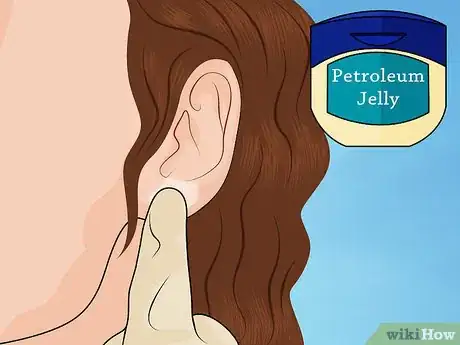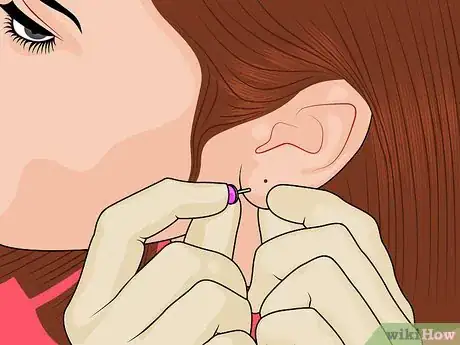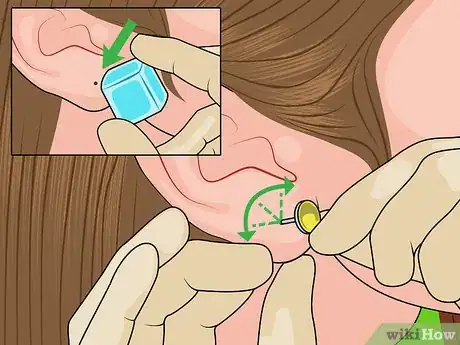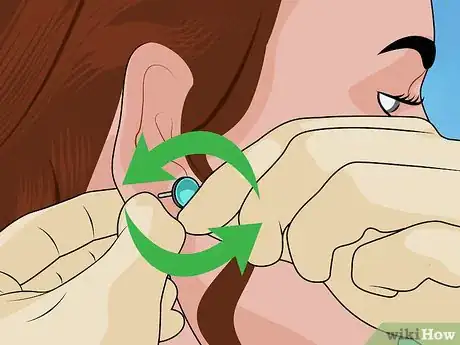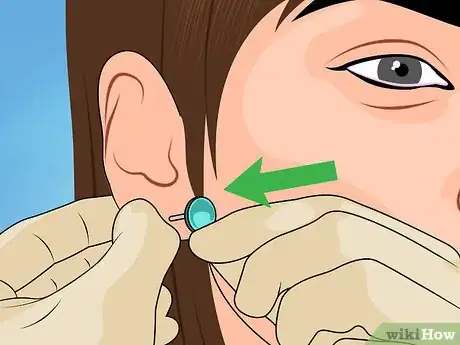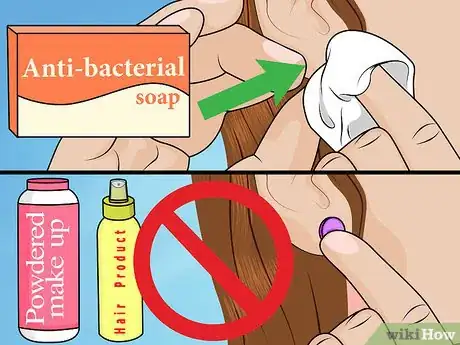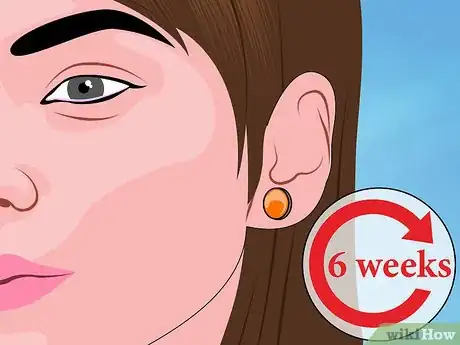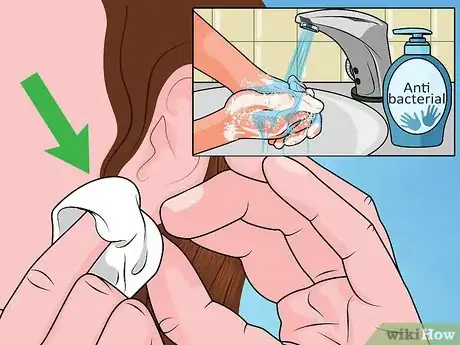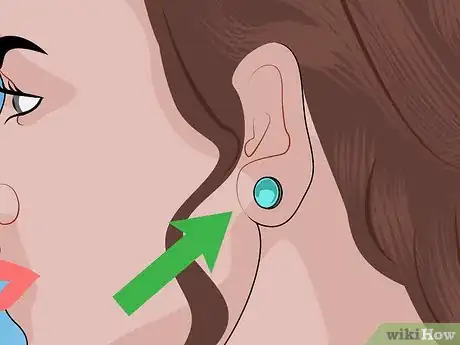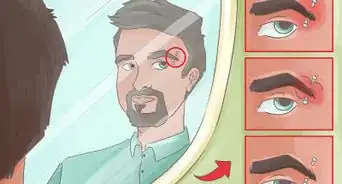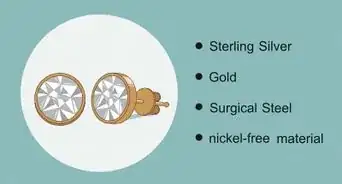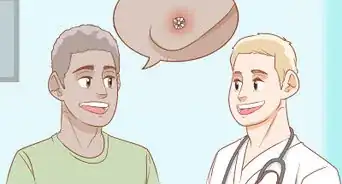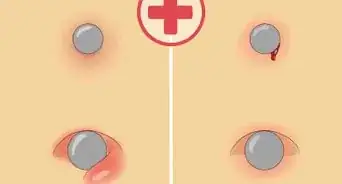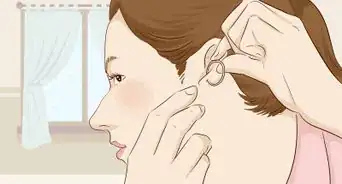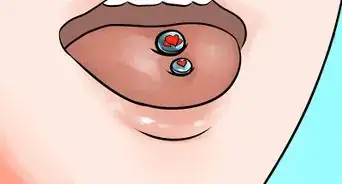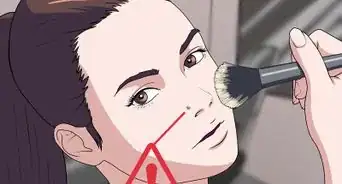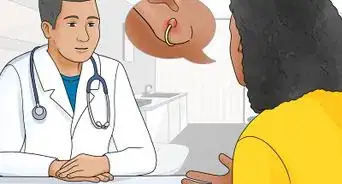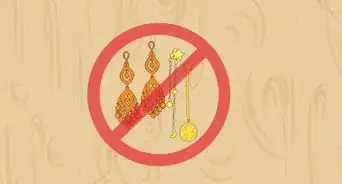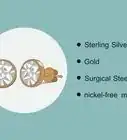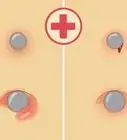This article was co-authored by Karissa Sanford. Karissa Sanford is the Co-owner of Make Me Holey Body Piercing, a piercing studio based in the San Francisco Bay Area that specializes in safe and friendly body piercing. Karissa has over 10 years of piercing experience and is a member of the Association of Professional Piercers (APP).
There are 7 references cited in this article, which can be found at the bottom of the page.
wikiHow marks an article as reader-approved once it receives enough positive feedback. This article received 12 testimonials and 87% of readers who voted found it helpful, earning it our reader-approved status.
This article has been viewed 708,372 times.
Wearing earrings is a fun way to accessorize or transform your look, but if you do not wear earrings often, your piercings may begin to heal and close up. Professional help may be needed in some circumstances, but it is possible to reopen the hole at home if you sterilize your environment, work slowly, and take care to prevent pain and infection. With careful preparation and patience, you can safely reopen an earring hole and begin wearing earrings again.
Steps
Sterilizing Your Environment
-
1Soften the skin around your earlobe. Before attempting to reopen your earring hole, soften the skin by holding a warm washcloth to your earlobe or by taking a warm shower. This will make it easier to reopen the hole.[1]
-
2Wash your hands and wear latex gloves. Thoroughly wash your hands with warm water and antibacterial soap for 30 seconds to remove any dirt, debris, or bacteria. After you have completely rinsed and dried your hands, put on a pair of latex or rubber gloves. This will help prevent you from introducing bacteria into the earring hole.[2]Advertisement
-
3Disinfect your earrings with rubbing alcohol. Isopropyl alcohol, commonly known as rubbing alcohol, can be found at a local grocery store or pharmacy. Rubbing alcohol is a strong disinfectant and kills most bacteria, fungi, and viruses living on a surface. Dampen a cotton ball or a cotton swab with the rubbing alcohol and clean a pair of earrings that have thin posts. You will be using these earrings to open your earring hole. Make sure you thoroughly clean the surface. Place the earrings on a clean surface to dry.
- If you have allergies, be sure to use a sterling silver or hypoallergenic earring to avoid an allergic reaction.[3]
-
4Clean your earlobe. Use a new cotton ball or cotton swab to clean your earlobe with rubbing alcohol. Be sure to clean the front and the back of the lobe, and pay close attention to the opening of the earring hole.
Manually Opening the Earring Hole
-
1Feel the back of your earlobe. You may feel a small knot where the piercing hole should be. This is knot is composed of dead skin cells, which block the piercing hole as it tries to heal.
- If the hole seems to have healed entirely, you may need to seek the help of a professional to have your ears pierced again. Keep in mind that every person’s healing time varies. You may be able to go several years without wearing earrings and still be able to reopen the hole at home, or your hole could close completely after many months.[4]
EXPERT TIPKarissa Sanford is the Co-owner of Make Me Holey Body Piercing, a piercing studio based in the San Francisco Bay Area that specializes in safe and friendly body piercing. Karissa has over 10 years of piercing experience and is a member of the Association of Professional Piercers (APP).Body Piercing Specialist
 Karissa Sanford
Karissa Sanford
Body Piercing SpecialistYour piercing hole has likely shrunk, not closed. Without jewelry in it, piercing holes tend to shrink, not always close. If the hole was completely healed when you took the jewelry out, it's less likely it closed completely. You can usually find a reputable piercing shop and have a professional reopen a partially closed or shrunken hole.
-
2Lubricate your earlobe. Spread a generous amount of petroleum jelly or an antibiotic ointment over the earlobe to lubricate the area and reduce friction.[5] Using your fingers, carefully rub the lubricant onto your earlobes. The added heat from your hands will also help soften the skin.
-
3Stretch the earring hole. Using your fingers, gently pinch the sides of your earlobes and lightly pull in opposite directions. This will help the earring hole to open up slightly.[6] This can help push some of the lubricant into the earring hole. Do not rub or pull on your lobes with too much force.
-
4Coat the disinfected earrings with a lubricant. Add a thin layer of petroleum jelly or antibiotic ointment to the disinfected earring posts. Try to avoid getting the lubricant on the front of the earring so you do not have any issues keeping a firm grasp on the earring.
- Be sure that you are using earrings with thin posts. Thick earring posts may not be able to fit through a slightly closed ear piercing hole. Forcing a thick post into the earring hole may cause pain, scarring, or bleeding to occur.
-
5Insert the earring into the piercing hole. While looking in a mirror, slowly insert the earring through the front with one hand. Use your free hand to grip your earlobe. Lightly press your thumb against the back of the piercing hole, where the knot of dead skin cells is located.
-
6Wiggle the earring in the piercing hole. Gently move the earring around the opening of the earring hole. You may also need to wiggle the earring around for several minutes to find an appropriate angle that allows you to push through the earring hole.[7] Keep your thumb placed at the back of your earlobe so you can feel the location of the tip of the earring post.
- If you feel discomfort or pain, try numbing the earlobe with ice for a few minutes before trying again.[8] If you continue to feel pain or discomfort during this process, you will need to seek the help of a professional.
-
7Twist the earring though to reopen the hole. Once you've found the piercing hole and the proper angle, slowly twist the earring through the hole. Do not apply too much pressure.[9] Since the piercing hole is partially open and the ear and earring post are well-lubricated, the post should feel as though it can easily slide through.
- If you cannot twist the earring through, stop and slowly insert the earring from a different angle.
-
8Push the earring through. After you have twisted the earring around the hole to reopen it, gently push the earring post all the way through. Secure the earring with the earring back.
- Do not jam or force the earring in. This can lead to scarring or infections.
-
9Avoid infections after reinserting your earring. After you have inserted the earring, be sure to wash your earlobe with warm water and antibacterial soap to prevent irritation or infection. It is important to keep your hands away from the earlobe as the lobe heals to avoid introducing bacteria into the opening. Avoid using hair products and powdered make-up for several days to ensure that the area remains clean.[10]
-
10Seek the help of a professional. Reopening an earring hole without proper care and sterilization can lead to blood loss, infections, and nerve damage. If you experience pain or are unsuccessful trying to reopen the piercing, do not continue.[11] Talk to your doctor or a professional at piercing parlor or jewelry store about safely reopening your earring hole in a licensed and sterile environment.
Taking Care of Your Piercings
-
1Keep your earrings in for several weeks. After you have reopened your piercings, plan to keep your small earrings inserted for at least 6 weeks. If you remove the earrings earlier, the holes may begin to grow over again.[12]
-
2Clean your ears with soap and water. Establish a cleaning routine every morning or evening. Use antibacterial soap to wash your hands, and then wash your earlobes with warm water and soap once a day. This will help keep the area clean and prevent it from becoming infected.[13]
- You can also help prevent scabbing by cleaning the area with rubbing alcohol twice a day. Use a cotton ball or cotton swab and apply the rubbing alcohol around each piercing.
-
3Twist the earring daily. With clean hands, gently grab the earring and twist. Do this movement every day to prevent the piercing from closing again.[14]
Community Q&A
-
QuestionWhat will happen if you just literally push the earring through without any of these steps?
 Community AnswerIt's best not to do that. If you force the earring through, you're risking intense pain, possible infection, crooked alignment, and permanent nasty scarring. Be gentle with your piercing, and go to a doctor or nurse for help if necessary. It's a safer and easier option than trying to force the piercing in.
Community AnswerIt's best not to do that. If you force the earring through, you're risking intense pain, possible infection, crooked alignment, and permanent nasty scarring. Be gentle with your piercing, and go to a doctor or nurse for help if necessary. It's a safer and easier option than trying to force the piercing in. -
QuestionI got my earrings back in but how long do I have to wait until I can change them again?
 Community AnswerWait for 2-3 weeks. The longer the better, try to be patient.
Community AnswerWait for 2-3 weeks. The longer the better, try to be patient. -
QuestionHow do I keep it so my ears don't close up?
 Community AnswerIf it's a new piercing, keep the starter earrings in for six weeks. Then switch to other earrings, but keep them in at all times for six months. Afterwards, it should be safe to take them out. It's recommended that you wear a pair at least once a week to prevent the hole from closing up. However, for some, the holes may quickly close up if earrings aren't worn on a daily basis. If you've recently reopened your piercings, wear your earrings for a few days, and keep twisting them to keep the hole open. If you're worried that they might close up, you could also wear them to sleep. After that, it might be safe to occasionally remove them.
Community AnswerIf it's a new piercing, keep the starter earrings in for six weeks. Then switch to other earrings, but keep them in at all times for six months. Afterwards, it should be safe to take them out. It's recommended that you wear a pair at least once a week to prevent the hole from closing up. However, for some, the holes may quickly close up if earrings aren't worn on a daily basis. If you've recently reopened your piercings, wear your earrings for a few days, and keep twisting them to keep the hole open. If you're worried that they might close up, you could also wear them to sleep. After that, it might be safe to occasionally remove them.
Warnings
- If you notice excessive redness, swelling, or experience pain in your earlobe, seek medical attention.⧼thumbs_response⧽
Things You'll Need
- Earrings with thin posts
- Antibacterial soap
- Clean hands
- Rubber gloves
- Rubbing alcohol
- Cotton balls or cotton swabs
- Petroleum jelly
- Antibiotic ointment
References
- ↑ http://goaskalice.columbia.edu/answered-questions/it-possible-reopen-closed-piercing
- ↑ http://goaskalice.columbia.edu/answered-questions/it-possible-reopen-closed-piercing
- ↑ https://www.youtube.com/watch?v=OUGlEyALYvI&t=119s
- ↑ https://www.youtube.com/watch?v=OUGlEyALYvI&t=119s
- ↑ http://www.cnn.com/2010/HEALTH/expert.q.a/08/30/earring.holes.closing.shu/index.html?eref=rss_latest
- ↑ http://www.cnn.com/2010/HEALTH/expert.q.a/08/30/earring.holes.closing.shu/index.html?eref=rss_latest
- ↑ http://goaskalice.columbia.edu/answered-questions/it-possible-reopen-closed-piercing
- ↑ http://thechart.blogs.cnn.com/2010/08/30/how-can-i-get-earrings-back-into-closed-holes/comment-page-1/
- ↑ https://www.youtube.com/watch?v=OUGlEyALYvI
- ↑ http://goaskalice.columbia.edu/answered-questions/it-possible-reopen-closed-piercing
- ↑ http://goaskalice.columbia.edu/answered-questions/it-possible-reopen-closed-piercing
- ↑ https://www.aad.org/public/skin-hair-nails/skin-care/caring-for-pierced-ears
- ↑ https://www.aad.org/public/skin-hair-nails/skin-care/caring-for-pierced-ears
- ↑ https://www.aad.org/public/skin-hair-nails/skin-care/caring-for-pierced-ears
